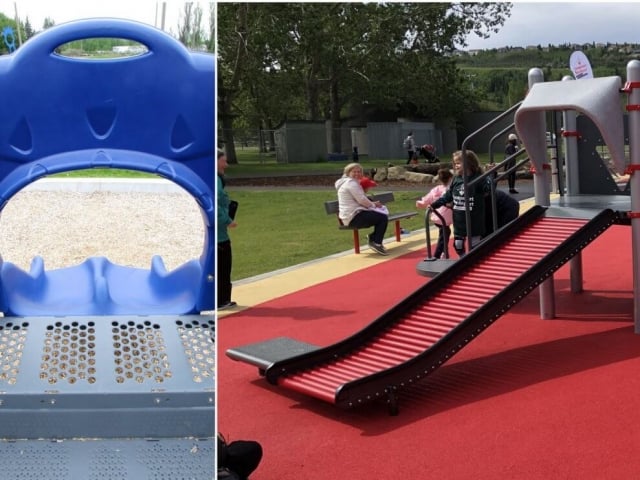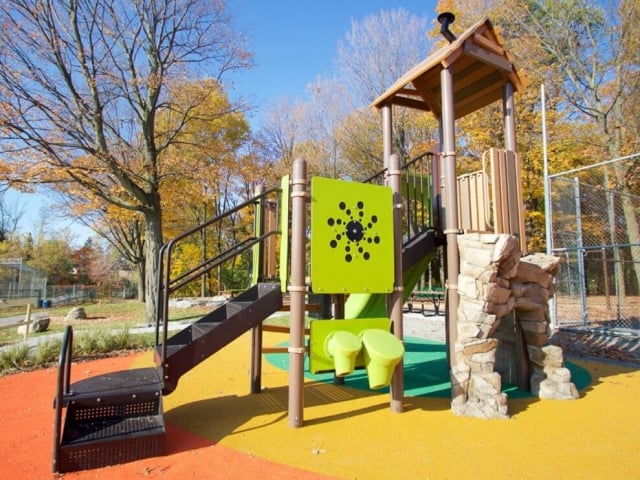
Why Canada needs more inclusive playgrounds
As a playground writer, I’ve visited hundreds of outdoor play spaces with my kids. But it wasn’t until at least a year after I started writing about playgrounds, when I saw a boy using a wheelchair who was unable to access any of the play structures at a newly built park, that I realized how many parks exclude children and adults with mobility challenges.
Unfortunately, many play areas also provide little to no stimulation for those with cognitive, emotional, or sensory disabilities.
This has to change.
The importance of accessibility
Playgrounds should be welcoming, fun, and encouraging places for all children to test the limits of their bodies and imaginations.
When a child with mobility challenges can’t access a play area because they’re unable to move on surfacing such as sand or pea gravel (both of which are difficult to cross with wheelchairs, for example), their opportunity to play and exercise their bodies ends before it can even begin.
Even a single game, workout or activity can improve the capacity to focus in children with disabilities. Physical activity can also contribute to better cognitive performance, memory, the ability to problem-solve and decision-making.”
– The Conversation
Below are some inclusive features that encourage play and physical activity for children of all abilities. Click on an image to start the slideshow.
Unfortunately, some supposedly accessible playgrounds have outdated or pointless equipment, such as wheelchair ramps that lead nowhere and adaptive swings over wheelchair-inaccessible sand. Older “accessible” playgrounds also rarely include features for children with sensory disorders.
As Zainab Alsmadi, a Montrealer whose young son lives with a physical disability, pointed out to me, when children can’t be wheeled close to adaptive swings, parents or caregivers have to carry them across sand or gravel. As children grow bigger, it becomes physically difficult to take them to these parks.
Related read: Kids of all abilities get added benefits through activities that develop physical literacy
Alsmadi said the majority of the parks near her home don’t even have adaptive swings or other equipment that her son can use.
“For parents of special-needs kids, it’s painful to watch other children utilize our public spaces, and meanwhile our children cannot,” she said. “All municipalities should make accessible and inclusive parks a priority in order to support the quality of life for all families.”
Statistics Canada’s most recent study that included children and youth 15 and under—the Participation and Activity Limitation Survey (PALS, 2006)—found that 6.3 per cent of children under 14 had an identified disability (that’s a total of 202,350 kids across Canada). Many parents or guardians indicated their children experienced disadvantages in playing and exercising as a result of their disability.
Some positive changes
The good news is that more parents and community organizations are advocating for children with disabilities, which is creating real change. Provincial laws such as the Accessibility for Ontarians with Disabilities Act are also spurring municipalities to invest in creating new parks that are barrier-free, and renovate older playgrounds to include inclusive equipment.
Related read: How playgrounds helped my special-needs son develop physical literacy
Cities benefit from inclusive, universally designed playgrounds because they’re not just for some children, but all children. Inclusivity is about much more than just wheelchair access. It includes considering the needs of those with an autism spectrum disorder, intellectual disabilities, visual or hearing impairments, sensory developmental delays, or other challenges.
Playgrounds are vital spaces for introducing physical literacy, where children of all ages and abilities can play to the greatest extent possible, and families can have valuable interactions with one another in community spaces designed to include everyone.
Photos courtesy of Christine Latreille and Dana Wheatley of Calgary Playground Review.


















Great post! We are Lugar Común (lugarcomun.cl), a playground company located in Chile, We design and manufacture in Chile and We are so focused on this topic.
On 2020 We were part of the team that developed the new inclusive playground chilean standard, and this year our playgrounds have been certified by an specialist organism. If you want to see our designs, you can visit our website.